REBECCA RENNIE BIG BOARD: SMALL SCHOOL TOP 50 (Page 3)
By Rebecca Rennie
As with every draft class, there is exceptional talent to be found outside the FBS. This presents my Top 50 of those small school prospects. This is year two of producing this form of content. Though less extensive than the Top 150 presented last year, I believe the process and resulting content is much better this time around. Surprisingly, the near 22,000 word count actually exceeds that of last year’s big board write up.
The first four pages provide profiles on the Top 40 small school prospects. Page 5 contains the full Top 50 Big Board as a list. There is a lot of high quality prospects in the 2021 class from the FCS and beyond. Those appearing near the bottom on the list are fully capable of enjoying a pro career with the right opportunity. There are a number of players also absent from this list. I’ve attempted to watch as many as possible but know that a few will have been missed.
There is a lot of content within this project, and would be surprised if many intend to read this start to finish. However, whether used pre-draft or after your team has picked up one or more of these players during or after the draft, I hope this provides some useful information or reference.
21. Mike Boykin, DL, North Alabama. Grade: 7th-HPFA
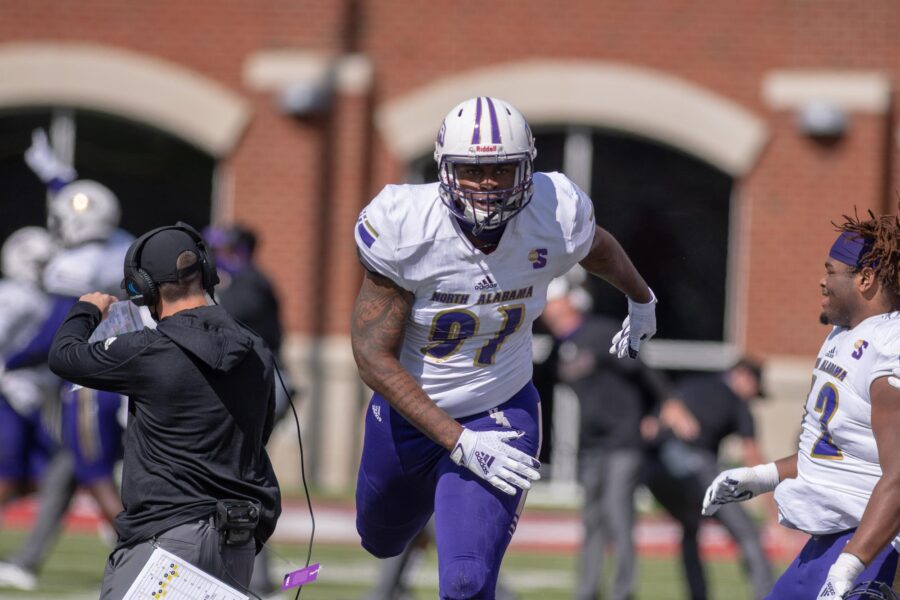
Height: 6’6”. Weight: 291 lbs.
Pros: With outstanding size and length, Boykin immediately stands out as having an ideal frame to work with and develop. The rangy defensive lineman features 6’6” length with 33” 5/8 arms, over 80” wingspan and 10” hands. The bulk is well distributed on his muscular frame. His solid pro day testing included a 4.88 dash at 9 lbs shy of 300, with a 32” vertical and 24 bench reps. The former Louisville signee was an invite to the Gridiron Showcase and took part in the Tropical Bowl All-Star week.
Versatility across the defensive line adds to Boykin’s potential value. Deployable inside and outside in both 3- and 4-man fronts, he is scheme-diverse. Though not featuring the best bend and flexibility, he can win outside by utilizing his advantageous length, working off contact and driving with his bull rush. When executing with appropriate leverage, he is capable of creating movement at the point of attack to generate early pressure. Fiery and passionate on the field, that energy can be a strong positive when channelled correctly.
His efforts off the snap and in the opening phase of rush attempts stand out. He can do so more consistently, but flashes good hand technique at the point of attack to counter and deflect blocks. He throws a useful swim move that can work for him at the next level. There are some nice examples of getting skinny as he shoots gaps. When in position, Boykin is typically a reliable finisher, using his length well to wrap up ball carriers. He can be punishing if left unblocked if offered only a glancing check.
Cons: His somewhat nomadic college career had an uncommon number of stops. Initially signing with Louisville out of high school, he ultimately did not enrol with the Cardinals at that time. He instead went to Mississippi Gulf Coast Community college, playing there in 2017. With good offers as a 4-star JUCO in 2018, he returned to Louisville to start 4 of 10 games played. He then transferred out to Tennessee State before landing at North Alabama for 2020. Teams likely will be interested to understand the path.
The flashes on film are fantastic, but the overall production has not been extensive, at least statistically. It would have been helpful to see some more tangible application of the obviously pro-caliber physical tools. While the energy can be excellent in the initial phase of snaps, he can ease off at times in the latter portions of some reps. Technique can be more refined and consistent. Boykin can play a little upright on occasion, limiting his leverage and power advantages and affecting his balance. The result is a share of stalemates in between the dominant wins.
Wrapping Up: Boykin has clear tools and upside, balanced against inconsistent execution and production. The draft buzz has been relatively low, but teams and scouts are sure to be aware of the measurables and traits. He performed well at the Tropical Bowl in an opportunity in front of NFL personnel. Primarily lining up at defensive end at the event, he also got to demonstrate his versatility inside also. Boykin has potential to be a late-round bargain if selected on Day 3 of the draft.
22. Michael Johnson, IOL/OT, Savannah State. Grade: 7th-HPFA
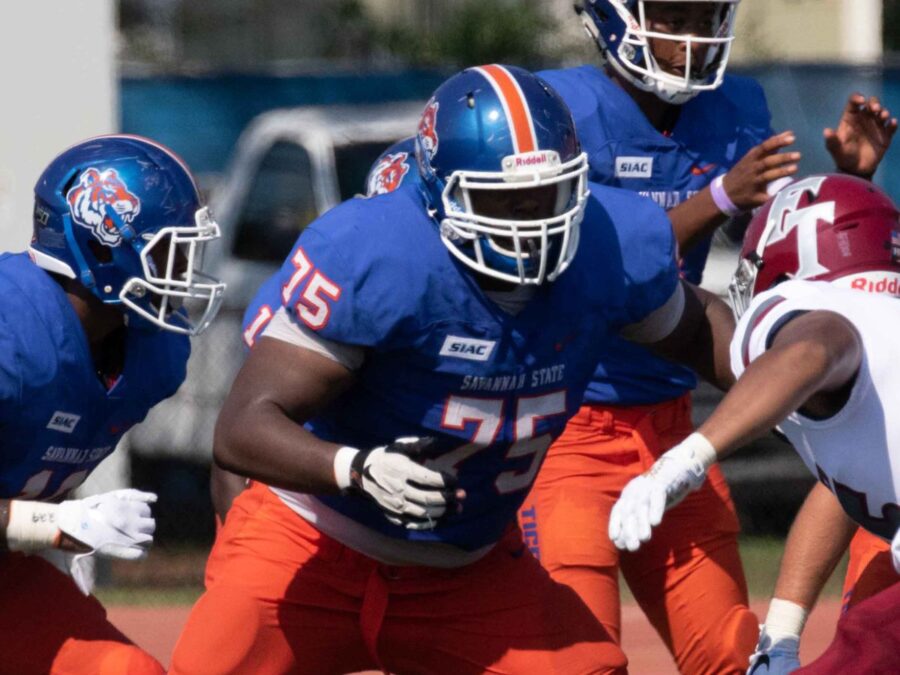
Height: 6’5”. Weight: 328 lbs.
Pros: Johnson had the option of returning for another season, but with a number of NFL teams showing interest, chose to take his shot at the league in 2021. After applying to the Tropical Bowl All-Star event, they responded that he was among their top prospect targets. It’s easy to see why. The Savannah State lineman looks the part with impressive size and length (over 34” arms), and a broad powerful frame. Some in attendance at the Tropical Bowl singled out Johnson as one of the standouts in practice.
In addition to his size, Johnson’s core strength is clear in his run blocking and generally in how he acquits himself at the point of attack. He brings a proactive approach to the initial blocking phase, looking to dominate early. There are some technical flaws, but the Tigers lineman seems to have decent natural balance despite at times blocking with poorer form. It was also notable during his Tropical Bowl and Hula Bowl performances that he has worked on the consistency of his technique and coordination, relative to his 2019 game film.
Johnson has experience at both guard and tackle, showcasing himself at both spots during the Tropical Bowl. He arguably projects better to the interior, where his power and anchor can be fully utilized. Though not featuring the quickest footwork and movement, he could potentially offer depth at right tackle also. It is noteworthy that Johnson has worked hard and done well academically, with both a bachelor’s degree and Masters.
Cons: Though the frame is ideal, there are athletic limitations evident in Johnson’s game. The Division 2 prospect therefore might fare better at guard than tackle. Some of the pro day numbers were less than ideal. However, he is a comfortable mover, not overly tight and can execute fairly well as a pulling guard. At times, the SSU lineman can be a little late out of his stance. This occasionally leaves him as one of the last to move off the snap and a step behind the action.
Johnson’s game film shows ragged, raw technique and form. He can lunge and bend as he reaches for contact and often has untidy footwork. Too often he will raise his pad level post-contact, get narrow in his base and lose leverage. He is generally able to hold on but negates some of his power advantage. The All-Star circuit showed better footwork and coordination but is still a work-in-progress, particularly with his pad level.
Wrapping Up: Johnson is considered to have a head-down, hard-working mindset that should take well to coaching. That is encouraging as he has plenty to tighten up with his raw technique. His big frame and core strength will surely result in a look in training camp at the very least. He grades here as a potential late draftable prospect.
23. Dai'Jean Dixon, WR, Nicholls. Grade: HPFA
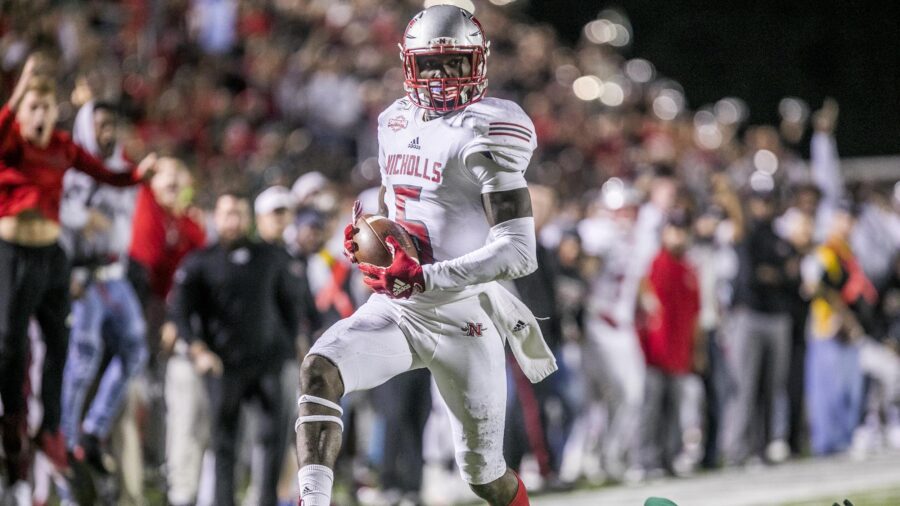
Height: 6’3”. Weight: 200 lbs.
*May return to school*
Pros: When the official 2021 Combine list was announced, Dixon was one of the lesser-known prospects to make the cut. An eventually recanted sexual assault charge cost him the opportunity to go to a more prominent program. He has traits worthy of exploring, following a consistently productive college career at Nicholls. His 2019 season included surpassing 1,000 yards in just nine games (over 19 yards per catch) and 8 touchdowns. Dixon has continued to play during the 2021 spring season.
Dixon features good length on a lean frame. Though not a dynamic athlete, the Colonels receiver is a smooth mover. Often a deep target for Nicholls, Dixon has the stride length to cover ground fairly well down the field. He finds success on contested catches through good concentration at the catch point. Maximizing his length on vertical jumps compliments his favorable catch radius to target. The hands are generally reliable, high pointing well and able to secure the ball away from his body.
Most outstanding from Dixon’s film was his clever route running and positional IQ. Though his routes can sharpen, he demonstrates impressive spatial awareness as he navigates space and sets up coverage. He shows excellent subtlety and timing as he sells his routes. There’s natural savvy in working through traffic over the middle of the field. He has a good knack for taking favorable positions relative to covering defensive backs. Involved across the field and on multiple levels, he can execute a relatively expansive route tree.
Cons: Though a smooth athlete, Dixon doesn’t appear overly dynamic or explosive with solid but modest top end play speed. The physicality and strength are ok but wouldn’t say he truly owns the catch point consistently. That said, he puts in a shift as a blocker and has his share of highlight catches under tight coverage. He has the hands to catch clean with extension but is not averse to favoring a body catch when the opportunity is there.
While the sexual assault charge was recanted, NFL teams will still do their due diligence on the incident back when Dixon was 17. They should receive positive referrals from the likes of his high school coach, who at the time talked about how little sense the accusation made relative to Dixon’s character. That all said, Dixon also has an August 2019 arrest to investigate, following a speeding traffic stop. He faced an alleged possession with intent to distribute marijuana charge. He also admitted to smoking weed and drinking alcohol prior to the traffic stop.
Wrapping Up: While his length and frame stand out at the FCS level, he might blend in a little more among NFL talent. There arguably are not “wow” traits among his skill set to offer a significant ceiling. The impressive feel as a route runner, fluid movement and an accommodating catch window to target are positives. Modest burst and physicality are questions and potential limitations. Dixon’s Combine invite reflects the interest level as a possible late round selection.
24. JaQuan Hardy, RB, Tiffin. Grade: HPFA
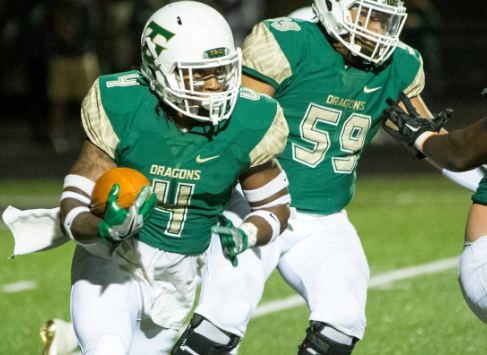
Height: 5’8”. Weight: 211 lbs.
Pros: Hardy is a D2 prospect with the size, power and athletic build to potentially make the jump to the pros. His solid pro day included a 4.56 dash with a 1.58 10-yard split. He added a 33” vertical, 9-11 broad jump, 6.98 cone drill and an impressive 21 reps on the bench. The Tiffin runner put up dominant production over lower-level competition over three seasons. He finished with a monster 2019 season that included 1,554 rush yards at 7.6 per attempt and 15 rushing touchdowns. A high character prospect, he has done significant community work and persevered to overcome a potential career ending injury.
The bowling ball back has an NFL caliber frame, short-area quickness and burst. The lower body explosion demonstrated results in some dramatic lateral cuts and shifts to evade potential tacklers. Hardy consistently makes full use of his shorter frame, low center of gravity and natural pad level. That contributes toward the impressive contact balance that is a staple of many of his highlight plays. He is regularly able to bounce off contact, maintain forward momentum, break tackles and extend runs for larger gains. Hardy finds ways to keep his feet in situations where most others would go down. He throws in an effective stiff-arm for added impact.
Cons: Hardy brings a lot of positives as a ball carrier, but currently lacks a well-rounded and complete skill set. There are improvements required as a receiver and pass protector. He has modest usage and production in the passing game, with a maximum of 15 catches in a season and 38 total over three seasons. His hands appear solid but can be imprecise as a route runner. A poor combination of recognition, setup and technique in pass protection, Hardy is currently unreliable in that area.
The Dragons RB takes advantage of being a better athlete and physical presence than most of the overmatched D2 competition he faces. That also means he can take some opportunities to dance in the backfield, extend plays laterally and overcome some questionable vision and decision making to still make positive plays. However, he likely will have to adapt and tighten up his running style for the step up from D2 to the pros. He has had some fumbling issues with 9 in three seasons, including 6 in 2017. He cleaned that up on his return in 2019 with just one fumble on the year.
The sometimes-questionable vision is noticeable both in the initial phase at the line of scrimmage in showing patience and setting up his blockers, as well as in space on the second level. There is not a great deal of nuance in how he sets up linebackers to declare early. As a result, he can be inconsistent at maximizing available potential yardage. Hardy has a possible medical red flag, missing the 2018 season with a knee injury. It was significant enough that there was concern as to whether he would be able to play again.
Wrapping Up: Hardy can be a frustrating watch at times. Incredible plays to escape tackles and bully his way through contact are contrasted by debatable feel, patience and vision in other examples. Improving his pass protection will be a must in order to earn snaps on offense. If he can refine his game however, he has clear NFL-level tools. Hardy is explosive and physical with outstanding balance. The upside may result in hearing his name on Day 3 of the draft. If undrafted, he should be quickly snapped up as a priority free agent.
25. Kion Smith, QB, Fayetteville State. Grade: HPFA
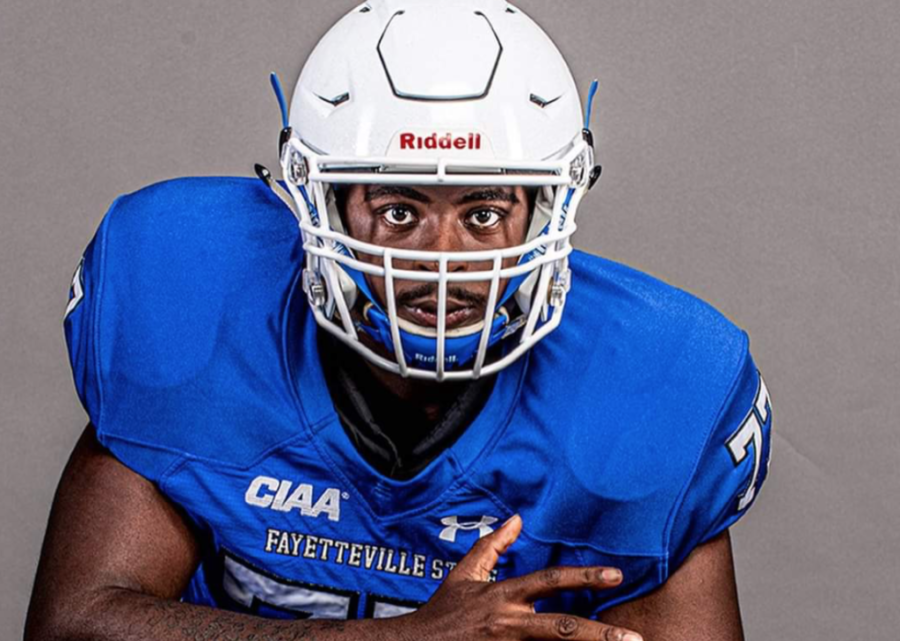
Height: 6’6”. Weight: 315 lbs.
Pros: A name not widely known, but Smith entered the season as a potential late round draft pick for some scouts. His 2020 season was lost due to the cancellations, but the Division 2 prospect has been on the recent All-Star circuit. Smith took part in the Tropical Bowl, Hula Bowl and Gridiron Showcase. He was noted as standing out for many during practices at the former. Awarded first team All-Conference in 2019, his junior film showcased his pro potential, despite the lower competition level.
The Broncos lineman measured in bigger than expected at the Gridiron Showcase. He weighed in at over 300 lbs, after looking slight on film and listed at around 295lbs in 2019. His appearances at the Tropical and Hula Bowls reflected that added bulk from his Fayetteville State film. He also measured in at 6’5” 5/8 with 34.5” arms. He played at RT and RG at the Tropical Bowl, and at LT in the Hula Bowl.
Smith’s film shows good athletic traits to compliment his length. Quickly out of his stance off the snap, he is fluid and flexible executing in pass protection. His changes of direction are sharp as part of good overall mirror skills. In addition to quick reactions, his anticipation of counters flashes well on film.
He generally plays with good footwork, pad level and keeping a wide base. Smith typically maintains his form throughout reps, including under pressure. Though not the strongest, his solid technique helps him to hold up at the point of attack. He makes good use of his extension, including mostly consistent hand placement.
Cons: Though reports from practice was positive, Smith’s performance in the Tropical Bowl game itself felt shaky. Too often he allowed a step to the opposing edge rusher off the snap and chasing to recover. Smith has some decent technique as listed above but is not averse to lunging for contact in pass pro.
Smith’s pro day numbers didn’t reflect a high-end athlete. While the added weight may not have been the largest amount, he didn’t appear quite as agile as his 2019 Fayetteville film showed. Ultimately though, the prevailing opinion on All-Star events are that practices outweigh the game itself, where Smith impressed. His Hula Bowl game showing was arguably an improvement on his Tropical Bowl film. By all accounts the events were a positive overall for his stock.
The reported added weight may assist, but the 2019 film suggests that Smith may not have the best core strength. In addition, his 15 reps on the bench press was not a standout total. He compensates well with his movement and length, but hopefully can add more power as he develops. The D2 prospect missed all of 2018 due to shoulder problems. That could be considered a medical red flag if there is any risk of future issues.
Wrapping Up: Should he end up drafted in the late rounds, he will be a relative unknown to most watching the event. Smith absolutely has length and movement that can translate to the pro level. He would be something of a flyer and a long-term developmental prospect. However, he has shown enough to warrant that opportunity. The offensive line, particularly tackle, is a premium position that has all teams searching for hidden gems.
26. Nate McCrary, RB, Saginaw Valley State. Grade: HPFA
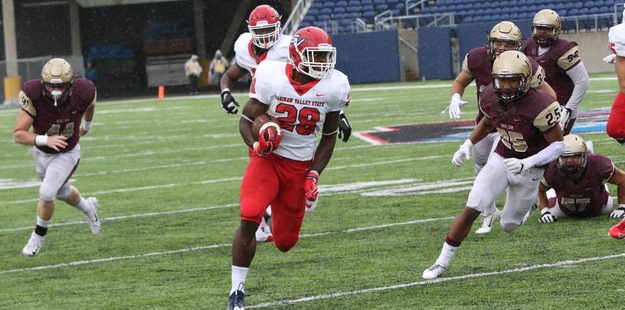
Height: 6’0”. Weight: 220 lbs.
Pros: Already an interesting prospect, McCray has garnered some wider attention in part due to some notable testing results. Taking part at Central Michigan’s pro day, the SVSU runner reportedly ran in the low 4.4s (high 4.3’s on some watches). He added a 36” vertical, 10-5 broad jump, 4.06 shuttle and 19 bench reps. If accurate, the result is an appealing size, strength and speed profile. The play speed on film may not quite live up to the numbers but clearly has nice burst for his size.
Though taller than some backs, McCray is frequently able to lower his pads into contact with good form and leverage more often than not. Once free on the second level, he proves difficult to take down at maximum velocity. A good straight-line athlete, he also shows some shift as he navigates through bodies between the tackles. While particularly impressive when heading north, he can surprise with some effective jump cuts and bouncing the action outside.
McCrary is at his best utilizing his size and physicality. He takes on tacklers proactively as he absorbs hits. He plays up to his physical traits between the tackles and does not go down easily to the first defender. A solid power-through-contact runner, he has the leg-drive to gain good yardage after contact, finishes runs and routinely fall forward.
With more to his game that just physical attributes, McCrary should not be undersold for his positional IQ. He flashes some nice patience to set up his blockers. The Cardinals runner is generally a reliable decision maker with trustworthy vision. With a nose for the end zone, he has piled up 28 rushing scores over three seasons. The All-GLIAC 1st teamer surpassed 1,000 rush yards in 2019 at 6.3 yards per carry.
Cons: The lack of usage as a receiver in the passing game is one of the primary concerns with McCrary. Whether just a function of the offense or a reflection of his abilities, he has had minimal impact in that area of the game. He totalled just 12 receptions over three seasons, with only two in his final year in 2019.
While there are good examples of reducing his pad level, there are his share of runs in which McCrary plays more upright. It generally does not negate the power element to his game against Division 2 defenders. However, more consistent pad level will aid his chances of continuing to be productive at the NFL level.
Wrapping Up; Several undrafted small school running backs have found success in the NFL when landing with the right team. The Chargers’ Austin Ekeler and James Robinson of the Jaguars last year are prominent examples. McCrary has potential of being the next, given his intriguing combination of frame, power and movement at his size. He has developmental potential, possibly via the practice squad initially.
27. Samuel Cooper, IOL, Merrimack. Grade: HPFA
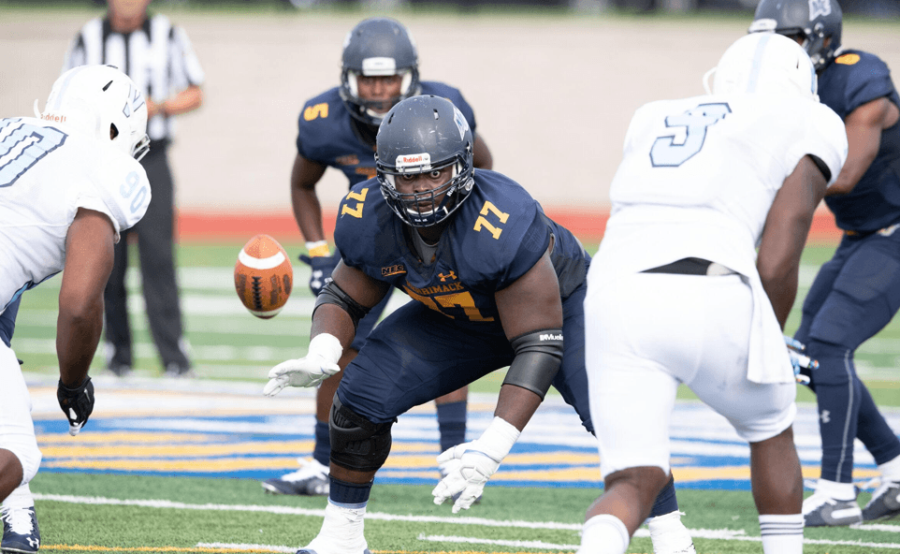
Height: 6’2”. Weight: 305 lbs.
Pros: There are clear signs that NFL teams have interest in Cooper. The interior line prospect received invites to the Tropical Bowl, Hula Bowl, and the cancelled East-West Shrine event. After an excellent pro day, a large number of teams have reportedly spoken with Cooper. A two-year starter after transferring from Maine, he was a team captain in 2019. Highly driven to succeed in his dream to reach to pro level, Cooper is respected for his work ethic, including excelling academically. He has overcome personal tragedy and loss that contributes to an already motivated mindset.
Cooper has a shorter frame but looks to be a well-proportioned and toned athlete. He brings good power within his stout, stocky frame, along with enough lower body explosion and movement. His 35 bench reps during pro day testing backs that up. Cooper attempts to apply his strength at the point of attack, bringing an aggressive initial punch. He impresses with his motor to drive and finish each snap. His best reps see him exploit his natural leverage and power to knock back defensive linemen.
Cons: Cooper was unable to play much during three seasons with Maine, prior to his transfer. Injuries were reportedly a big factor keeping him off the field. Those included multiple broken fingers, a partially torn patellar and an ankle injury. After the Merrimack transfer, Cooper was again injured in the spring game, costing him several games to start the 2018 season. The frequent injury troubles likely will be flagged by scouts.
At times, his technique will see him forced back into the pocket or on the turf more than ideal. His form can deteriorate over the course of a snap, particularly if he’s on the backfoot early. Cooper has a naturally lower pad level but still has a tendency to get narrow and upright in his stance as he engages and as the play progresses. This can affect his leverage and balance on some of his poorer reps.
Wrapping Up: The application and refinement may not be there yet. However, there are a lot of likeable physical, athletic and mental traits to work with. Work on his consistency and raw technique could pay off long term. It’s easy to buy in the character to give himself every chance to succeed. The buzz has built over the final weeks leading to the draft. Many are now projecting Cooper as a Day 3 draft selection.
28. Lawrence Woods, CB, Truman State. Grade: HPFA
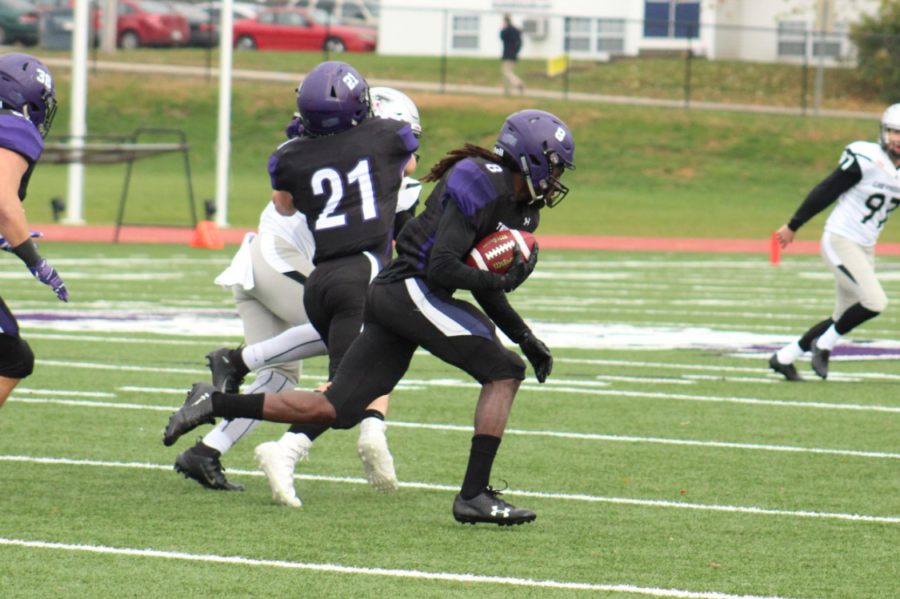
Height: 5’10”. Weight: 182 lbs.
Pros: A small school corner of Woods’ frame typically will have a challenging path to the pros. The Division 2 prospect has a couple factors in his favor, however. Woods has the well-rounded athleticism and quickness to compensate somewhat for his lack of length and bulk. He also adds special teams value as a prolific returner in college. He has the potential to continue to contribute as a key special teamer at the next level.
Pro day times for Woods are reported in the 4.48-4.52 range, notably during unideal 38 degree conditions. He also compiled a 37.5” vertical, 10-4 broad, 4.28 shuttle, 7.08 3-cone and 13 bench reps. His returner history included 5 kick return touchdowns, with 3 in the 2018 season. A playmaker on defense as well, Woods had 8 pass breakups and two interceptions in just 4 games in 2019. The dynamic athlete saw some snaps on offense in maximizing his impact. Woods had strong showings at both the Tropical Bowl and Gridiron Small School Showcase events.
Beyond the numbers, the Truman State DB looks polished and smart on film. The quick-twitch movement and acceleration reflect the solid testing numbers. Comfortable in his backpedal, Woods is fluid working backward, as well as forward and laterally. The footwork overall is efficient, impressing with his ability to stop and redirect, to click-and-close with speed. The complimentary energy and high-motor play style is excellent. Though slightly built, Woods brings a safety-like mentality to his game. He uses his momentum to add force to his committed tackling efforts.
The Bulldogs corner looks proficient in a number of assignments and techniques. While lacking length, he attempts a forceful punch from press and is adept at flipping his hips and accelerating to stay in phase following the initial exchanges. Meanwhile, Woods shows good discipline and positioning from zone coverage. He appears to possess the appropriate processing skills, awareness and recognition to effectively execute within his assigned zone. He shows good instincts in picking up and passing off receivers within his area of responsibility.
Cons: There are a number of quality traits to buy into, yet the size at 5’9” 1/2 and 30” arms is limiting. His most recent weigh-in of 182 lbs is slight, though a positive improvement of a previous low 170’s listing. He has excelled on the field but also missed his share of playing opportunities.
After an impressive 2016 freshman season, Woods took a redshirt year in 2017, believed to be for academic reasons. He had an impactful opening to his 2019 redshirt junior season. That was cut short after four games however due to a torn ACL. That knee injury may be of concern, though by all accounts he made a full recovery and has maintained his burst and agility.
Wrapping Up: Referencing Devin Hester as an influence, Woods’ special teams impact has helped raise his profile. As impressive as he is as a returner, there is so much to like about his qualities as a corner on defense also. The lack of ideal size and length is limiting but he has the athleticism to compensate. He can develop and earn snaps on defense with the right opportunity. Earning a key role on special teams units can buy him some time should he find that fit. A practice squad place is a possibility also.
29. Kevonta Moses, FB/TE/WR, Shaw University. Grade: HPFA
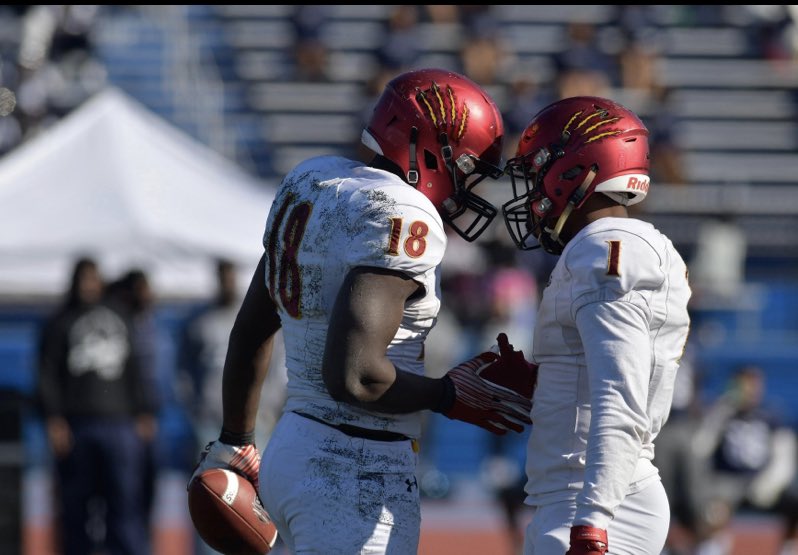
Height: 6’0”. Weight: 235 lbs.
Pros: A Division 2 prospect, Moses played two seasons at Shaw after a transfer from Dakota College at Bottineau Community College. Moses attended both the Tropical and Hula Bowl All-Star events. He was also invited to the HBCU Combine. The 2nd team All-CIAA selection totalled 37 receptions for 510 yards (13.8 average) and 9 touchdowns in 2019. Primarily a tight end at Shaw, he played mostly that role at the Hula Bowl, but largely at receiver at the Tropical Bowl. He may project best at full back for the pros. Add in special teams and Moses has the potential to be used in multiple ways at the next level.
He features a powerful, broad build that he utilizes well. Moses plays with strength and balance, making effective use of his base, core, leverage and relatively lower center of gravity. Moses imposes himself as a route runner and as a runner after the catch. While his toughness invariably impresses, he also shows smart execution, footwork and polish, compensating for modest burst. He shows a good sense of space over the middle where he sees most of his targets.
The Bears’ versatile weapon has superb hands, and film frequented by outstanding high-difficulty catches. He is adept in snatching the ball outside of his frame, off-target throws from behind and one-handed highlight grabs. More conventional receptions see Moses track the ball instinctively and catch well in stride. He is equally as tough to disrupt at the catch point as he is to bring down by a single defender when he gets going with the ball in his hands. A nasty blocker, Moses works well both inline and as a lead blocker. He often overpowers and drives defenders back effectively.
Cons: Moses has an unconventional frame and length for wide receiver and tight end. An H-Back and full back role could be a projected best fit. He can absolutely excel in such a role and as a talented pass catcher but might have fewer teams available who will properly make use of his versatility.
His game is based more around power and sound technique than dynamic movement. Good footwork helps, but Moses isn’t the most explosive or laterally agile. Routes and releases are well executed but somewhat limited by acceleration and burst.
Wrapping Up: Special teams and depth at several spots could earn Moses roster spot. His film is lively and compelling, featuring physicality and flashes of playmaking. An established NFL contributor such as Anthony Firkser of the Titans comes to mind as a possible positive comparison for Moses to emulate.
30. Caleb Johnson, LB, Houston Baptist. Grade: HPFA
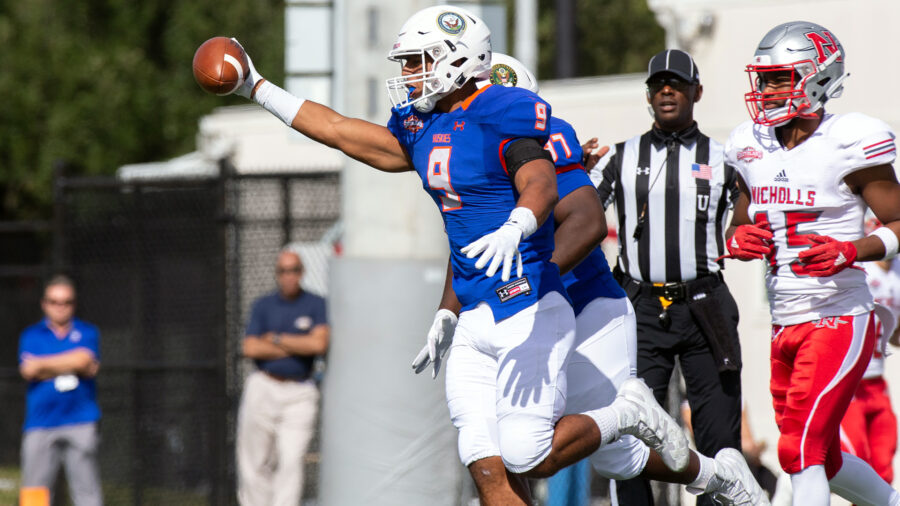
Height: 6’3”. Weight: 226 lbs.
Pros: When Houston Baptist almost shocked Texas Tech early in 2020, quarterback Bailey Zappe received many plaudits. He was certainly not the only Huskies standout, however. Caleb Johnson, a draft-eligible linebacker, had a big impact in his own showcase opportunity. The redshirt senior totalled 13 tackles and 1.5 TFLs during his productive outing against the Red Raiders. That active performance was no fluke for Johnson. His 49 tackles in 4 games in 2020 followed on from back-to-back 100+ tackle seasons.
With good range of field influence and lateral agility, Johnson has the short area quickness and explosiveness to arrive to the action on time and to achieve favorable angles. His 40-yard dash time was modest but otherwise his testing echoed the burst and change of direction evident on film. He had a 38” vertical, 10-1 broad jump, 6.89 3-cone and 19 bench reps as part of his pro day numbers. Invited to the Gridiron Small School Showcases event, he stood out as one of the better athletes in attendance. Johnson is fairly slight in build but with decent length and good sideline-to-sideline range.
Though not the most dense or bulked up, his motor and burst aid him through traffic and between the tackles. He may not stack-and-shed blocks consistently but can be slippery and able to use his agility and change of direction to work into positions. Despite some misreads, he is active around the football with recovery quickness. Effective with run-and-chase, he closes well to make plays on the second level and in space.
Johnson makes occasional splash plays in the backfield with some blitzes up the middle and second effort pursuit. Comfortable dropping back, he flashes potential to be functional covering tight ends and running backs in the passing game. Varied in his deployment, he’s also seen use as a rusher off the edge in certain situations. He appears to have the traits and mentality to earn a key special teams role.
Cons: Most of Johnson’s athletic testing results were excellent. The 40-yard dash was fine but a little more underwhelming. Running at 4.73 with a 1.64 split, he appears on film to play quicker than those numbers suggest. He may be looking at adding some extra weight to his 226 lb frame. If so, that hopefully does not come at the expense of his speed and range.
While highly productive and active on film, Johnson arguably needs to improve his recognitions and overall football IQ. He appears to be a work-in-progress with his reads, prone to some false steps and biting on early movement. He has shown recovery quickness to compensate at the FCS level but will be punished more at the pro level.
Wrapping Up: A little off-the-radar even by small school prospect standards, Johnson hopefully opened some eyes at the Gridiron Showcase. The Texas Tech film is a key one for his evaluation and makes for a positive first impression. The smooth movement and short-area quickness are part of an intriguing athletic profile as a developmental prospect. Bringing his plus effort to special teams duties can buy time to work on his game in the meantime. He could be an ideal practice squad candidate.
Feature Image Credit: NFL Draft Diamonds

rebecca rennie
CFB/NFL DRAFT analyst
Rebecca is an NFL Draft analyst focusing primarily on the FCS and Group of Five conferences, and a fan of both the Tampa Bay Buccaneers and Stanford Cardinal. You can find her other articles here and follow on Twitter @bex_r86.
